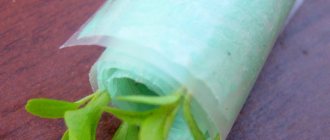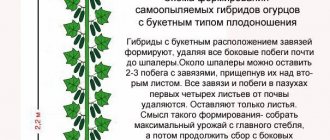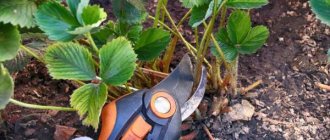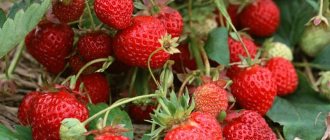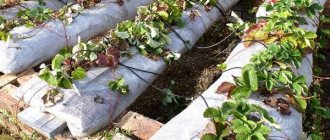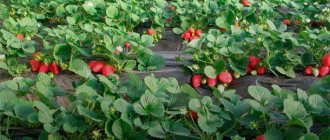Ripe, aromatic, incredibly tasty strawberries grown on the windowsill at a time when it is snowing outside is a real joy for the family!
In winter, not every supermarket offers fresh berries, and the price of strawberries is always prohibitively high at this time. In this article, we will look at self-pollinating strawberry varieties for growing at home, analyze the necessary growing conditions, planting and care rules, as well as what diseases and pests gardeners encounter when planting berries. Strawberries are very popular in our country and extremely healthy. To get a harvest in the winter, you can create a micro-farm at home and pamper your family with aromatic fresh berries throughout the year. And also, in conditions of scarcity, obtain financial benefits if desired.
What does self-pollinating strawberry mean?
Not every available variety of strawberry is able to successfully grow and bear fruit in a greenhouse. There are several criteria for selecting the desired option, the most important of which is self-pollination. In order for fruit to set, pollination must occur during the flowering period: the transfer of pollen from the anthers to the stigma.
There are two types of pollination:
| Cross | Self-pollination |
| Fertilization is possible only through the transfer of pollen from the stamens of a flower of one plant to the pistil of a flower of another plant. Cross pollination requires the presence of pollination agents, which are usually insects. | Fertilization occurs when pollen is transferred from the anthers to the stigma of the same flower or another, but on the same plant. In this case, you can do without pollination agents. However, their presence can increase the number of pollinated flowers and increase yield. |
Artificial pollination
During flowering, artificial pollination of strawberries is required. To do this, you can use one of the following methods:
- Using air flow. The wind can carry pollen even in natural conditions. Place a fan near the flower stalks - air currents will distribute pollen to the flowers.
- Hand pollination. In this case, you will have to process each flower manually. Use a soft brush for this, simply transfer the pollen from one flower to another.
- Bees. You can place bees in the same place where you grow strawberries. The most effective method, but here you will also have to take care of insects.
How to choose the right variety of self-pollinating strawberries for greenhouses
Self-pollination is an important, but not the only condition. When choosing the right variety, you must take into account that strawberries will have to grow and bear fruit in a special microclimate, and it must be able to adapt to it.
Growing conditions
The owner of the greenhouse will try to create the most comfortable environment for his green pets, but his possibilities are not unlimited.
Most private home-made structures have the following disadvantages that strawberries will have to put up with:
- small area and, accordingly, close fitting;
- insufficient lighting;
- lack of fresh air;
- cold soil (in winter);
- high humidity.
Regional affiliation
Considering all of the above, you should not choose capricious southern varieties for the greenhouse. It is better to opt for early-ripening strawberries, aimed at growing in the middle zone.
In this case, the ability to produce an early harvest is unimportant; other advantages characteristic of these varieties are more important:
- small bushes;
- unpretentiousness;
- short growing season;
- cold resistance;
- ability to cope with a small amount of sunlight;
- resistance to fungal diseases.
Requirements for greenhouse varieties
Strawberries for greenhouses (varieties for such conditions must be self-pollinating and early ripening) should produce good harvests several times a season and be distinguished by high-quality fruits.
Repairability
Repairability is the ability of a plant to bloom and bear fruit several times per season. In contrast to varieties that produce 1 (short-day strawberries) or 2 (long-day strawberries) harvests per year.
In open ground, remontant strawberries produce 4 harvests per season, stopping fruiting with the first frost, and in a warm greenhouse microclimate the process of formation and ripening of berries can continue all year round.
Maintenance is a prerequisite for year-round cultivation. Non-repairing varieties can also be grown in a greenhouse, but only to obtain a harvest earlier or to extend the fruiting period. However, using them for all-season cultivation is unprofitable.
High yield
If, when planting in open ground, you can get a bountiful harvest by increasing the size of strawberry plantations, then this is impossible for a greenhouse. The space in it is limited, and every centimeter of space must be used to maximum benefit. Therefore, you will need to select a variety that can produce a large amount of berries at minimal cost.
When growing in greenhouses, crops with a yield of at least 2 kg of strawberries per bush are used. For comparison: when grown in open ground, an indicator of 1.5-2 kg per 1 m2 is considered good.
Commercial qualities
These criteria are more important provided that greenhouse strawberries are grown for sale.
Berries will become a popular product and will attract buyers, despite the “winter” prices, if they have the following advantages:
- average berry size;
- their correct shape;
- elastic dense pulp;
- high taste qualities;
- transportability;
- ability to be stored for several days.
Customer reviews:
The advantages of the miracle berry over store-bought strawberries are obvious: it is a tasty and healthy berry that is loved by both adults and children; will bear fruit regularly, under good conditions - every 2 weeks; the cost of home is much lower; one box takes up very little space and will fit even on a small windowsill; an environmentally friendly product will grow that can be consumed without heat treatment; ease of care. yield all year round, even in winter. The Albion variety has only one drawback - the lack of frost resistance, but in apartment conditions the drawback disappears on its own; Boxing with strawberries does not harm the ambient air in the room and does not emit harmful substances. Several pieces will easily fit on a standard windowsill and will allow you to grow a large number of strawberries.
Strawberry miracle berry has a lot of useful properties, like any berries and fruits. It is rich in vitamins A, B, C. The berries contain potassium, phosphorus, iron, calcium, and copper. Positively affects hormonal levels. Suitable for food and cosmetic purposes, it can be used for masks. Rejuvenates the body, improves skin condition. Strengthens memory and supports vision. Increases hemoglobin.
Source: mirobaby.com
Methods of growing in a greenhouse
Protected soil gives the gardener many advantages:
- growing strawberries all year round;
- protecting the plant from the negative effects of aggressive weather factors;
- higher yields (on average 25% higher than for ground strawberries);
- the ability to choose a growing method.
Growing in soil
The simplest method, but requiring large areas and the use of equipment capable of warming the soil to the desired temperature. To ensure that the plants receive maximum light and heat, the beds are placed in the direction from north to south. Their optimal width is 1 m.
The preparation of the beds is carried out according to the following algorithm:
- Fertile soil is removed.
- A layer of crushed stone (6 cm thick) is poured into the resulting trench.
- A layer of sand (10 cm) is placed on it, and even higher - a layer of chernozem (previously excavated soil).
- Holes are created 10 cm deep, located in a checkerboard pattern at a distance of 15-20 cm from each other.
- Fertilizers are placed at the bottom of each hole.
Typically, store-bought nutritional mixtures containing calcium, nitrogen, and phosphorus are used. From organic matter, you can take humus or manure-peat compost.
As seedlings, seedlings harvested independently or purchased from a nursery are used, which are planted in holes to the level of the rosette, no higher or lower, and sprinkled with soil.
Growing in a barrel
Strawberries for greenhouses (there are many varieties of berries) can be grown vertically. It will save space, but will require the creation of a perfect irrigation system.
Several holes are made in a barrel filled with nutrient soil, sufficient for planting strawberry seedlings. A hose connected to the drip irrigation system is supplied to the height of each level in advance.
Growing in bags
Advanced Dutch technology, which proposes using plastic bags for growing strawberries, allows you to more rationally distribute space in the greenhouse and save on heating. This method will require the creation of full ventilation, since in its absence the high temperature and humidity of the soil inside the bags will lead to it starting to rot.
Bags filled with soil are installed vertically or laid horizontally. To plant strawberry seedlings, circular holes are made in polyethylene at a distance of 20 cm from each other, where the seedlings are planted. Instead of bags, you can use boxes, containers, and pipes. A drip system is used for irrigation.
Hydroponic growing
A modern method, radically different from those described above, in that in this case soil is not used; the source of all the substances necessary for the plant is a nutrient liquid circulating through pipes, which is supplied using pumps to cups with filler in which strawberry seedlings are placed.
The method saves space, eliminates a number of labor-intensive operations (weeding, loosening, watering), but is complex and expensive to implement.
Features of planting and further care
With all the advantages of greenhouse cultivation, it should be taken into account that it will require:
- costs for arranging a greenhouse;
- maintaining the required parameters of temperature, humidity, illumination;
- renewal of planting material.
In order for the investment to pay off, you need to create optimal growing conditions for strawberries.
Soil preparation and planting
Strawberries of self-pollinating varieties for greenhouses love sandy and loamy soils with a slightly acidic reaction. You can use garden soil on which cereals grew.
It is not recommended to take soil from beds previously allocated for:
- pepper;
- tomatoes;
- potatoes;
- other nightshades.
If you want to get an ultra-high yield and get by with a minimum amount of fertilizing, it is advisable to prepare a special nutrient substrate.
To do this you need:
- Fill the container with straw and chicken droppings, add warm water and leave for a month.
- Stir the mixture twice.
- Add chalk, urea, and gypsum to the resulting mass.
- Disinfect the substrate by heating it to a temperature not higher than 60°C.
The prepared soil is used to create the top layer of the beds. Next, holes 10 cm deep are formed in it at a distance of 20 cm from each other, into which seedlings are planted.
To ensure continuity of fruiting during year-round cultivation, it is recommended to plant seedlings in batches, observing a time interval of 1.5-2 months, and using different beds for planting. Further care of plants comes down to maintaining optimal growing conditions.
Lighting
Since some of the sun's rays are blocked by film, polycarbonate or glass, and in the autumn-winter period the daylight hours are too short, artificial additional lighting will be required to provide the strawberries with optimal illumination for at least 13-15 hours a day.
In sunny weather, the light turns on twice a day: in the morning from 8 to 11, and in the evening, from 17 to 20. If it is cloudy outside, it should burn continuously. Use sodium lamps with a power of 400 W or more: 1 lamp per 3m2.
Temperature
In winter, it is enough to maintain a temperature in the greenhouse of 10-12 ° C during the day and 8 ° C at night. As daylight hours increase, it gradually rises to 20°C during the day; nighttime readings remain the same. During flowering, the temperature rises to 25°C.
Humidity
Strawberries love humid air: when planting and for 2-3 weeks after it, it should be maintained at 85%. Subsequently, by the time most of the bushes bloom, it is reduced to 70%.
Watering
Strawberries (self-pollinating varieties are chosen for greenhouses) are demanding on watering, but waterlogging of the soil can cause diseases of the root system.
Drip irrigation is the most effective because it:
- makes it possible to normalize the amount of liquid;
- helps save water and electricity required to heat it;
- facilitates the application of fertilizers;
- reduces the risk of developing infections.
To determine the required daily volume of water, you can calculate the total length of all beds (if their width is 1 m) and multiply the resulting value by 3. If it is impossible to organize a drip system, watering is carried out 2-3 times a week, in the morning, with warm, settled water, from calculation 3 liters per 1 m2.
Feeding
Intensive fruiting instantly depletes the soil; for this reason, fertilizing is applied weekly and, as a rule, combined with watering. Liquid mixtures containing nitrogen, potassium, phosphorus (ammonium nitrate, potassium salt, superphosphates) are used as fertilizers. The best organic option is chicken manure.
Bush pruning
Pruning bushes that are not used to obtain planting material is necessary for varieties that propagate vegetatively, and comes down to eliminating young shoots that take away strength from the mother plant and create excessive crowding in the garden bed. The mustache should be trimmed as it grows, at a distance of 5-7 cm from the stem, without waiting until it gets stronger and begins to take root.
Among the remontant varieties you can also find those that do not form a mustache and reproduce by dividing the bush.
Weeding, loosening
Growing in a greenhouse does not exempt you from weeding, although preliminary disinfection of the soil can reduce their number.
They must be removed regularly because weeds:
- create excessive condensation;
- take some nutrients from the soil;
- increase the risk of fungal diseases and pest damage to strawberries;
- create a barrier to sunlight and fresh air.
Loosening to a shallow depth, carried out to remove a dense crust on the soil surface, is combined with weeding.
Pollination
For self-pollinating varieties, the procedure is optional, but can increase yield. You can simply shake the bush slightly, or walk over the peduncles with a soft brush. This is enough to increase the number of pollinated flowers several times.
Preparation of planting material
Intense year-round fruiting leads to rapid “depletion” of bushes, a drop in yield and a decrease in the quality of fruits. There should always be seedlings at hand that will “replace” them. As a rule, rosettes (young plants that develop during the rooting of strawberry mustaches) of the 1st and 2nd order are used.
The strongest and healthiest bushes of the first year of life are chosen as the starting material. They are planted in a separate (mother) bed and all flower stalks are removed from the stems. From the emerging shoots, 2-3 of the strongest are selected, the rest are cut off.
The remaining tendrils are allowed to grow, but are not allowed to come into contact with the soil, for example, by directing them into the aisles where agrofibre is laid. When the mustaches reach the required length, they are rooted in previously prepared containers filled with nutrient substrate. With the appearance of leaves, the young plant is separated from the mother bush, and when its root system is sufficiently strong, it is planted in the garden.
When growing strawberries in a seasonal greenhouse, the procedure is slightly different:
- Seedlings are grown in the mother bed until late autumn, then dug up.
- The above-ground part of the plant is cut off, and the roots are stored until spring at a temperature close to 0o C.
- When the time comes for planting, the seedlings are brought indoors and a day later they are planted in the greenhouse.
To avoid degeneration of the variety, a complete replacement of plants is required approximately once every 5 years. In addition to the method described above, it is possible to propagate strawberries by seeds, seedlings grown from them, or by dividing the bush.
Preparing containers
They grow dugouts in a greenhouse directly on the beds. To save space, you can plant the berries in containers that are placed on shelves. Thus, there are several tiers with containers. To ensure normal development and fruiting, bushes require lighting. To ensure there is enough light for everyone, the distance between the tiers is maintained at least 50 cm. Some gardeners hang pots for this purpose.
Cereals are considered the best predecessors. That is why it is recommended to install the greenhouse in the place where they grew. You can take soil from the garden and deliver it to the greenhouse. In this case, it is not recommended to use the soil on which tomatoes, potatoes and peppers were grown. Soil preparation
To obtain a rich harvest, special soil is used. To prepare it, you need to mix chopped straw with chicken manure, gypsum, chalk and urea. The process looks like this:
- Chicken manure and straw are laid out in layers in the container.
- The contents of the container are poured with warm water and left for a month.
- During this time, the fermented mixture is stirred twice.
Chalk, gypsum, and urea are added to the resulting dark brown mixture. The resulting substrate is rich in calcium, nitrogen and phosphates. Thus, the crop will grow well and will not require a large amount of fertilizing.- The last stage is warming up. It is necessary to sterilize the substrate.
How to improve productivity?
We are constantly receiving letters in which amateur gardeners are worried that due to the cold summer this year there will be a poor harvest of potatoes, tomatoes, cucumbers, and other vegetables. Last year we published TIPS on this matter. But unfortunately, many did not listen, but some still applied. Here is a report from our reader, we would like to recommend biostimulants for plant growth that will help increase the yield by up to 50-70%.
We advise you to prepare in advance for the summer season, pay attention to this biological product. There are a lot of positive responses.
Read…
It is important to monitor the temperature; it should not exceed 60 °C. Otherwise, it will overheat and lose its beneficial qualities.
Self-pollinating strawberry varieties for greenhouses
Not all strawberries (for greenhouses, varieties that will meet all growing requirements are difficult to find) are suitable for growing in greenhouses.
Elizabeth II
Remontant strawberry, which is ideal for year-round cultivation in a greenhouse. When planted in open ground from late May to early November, it is capable of bearing fruit 2-3 times, producing large (with an average weight of 60 g) beautiful berries of bright red color with a glossy surface. The yield of the variety reaches 3.5 kg/m2 (for open ground) and 10 kg/m2 (for greenhouses) per season.
Elizabeth II - strawberry variety is ideal for growing in a greenhouse.
The ultra-early variety is different:
- good cold resistance (planting in open ground is possible in early spring);
- compactness (the plant can grow even in a flowerpot);
- ability to reproduce by means of whiskers.
Due to intensive fruiting, it requires regular fertilizing with mixtures containing nitrogen and potassium.
Gigantella
A hybrid characterized by incredibly large (the size of a matchbox) berries, the weight of which can reach 120 g. The average yield is 2.5 kg per bush.
The first fruits ripen in mid-June; when planted in a greenhouse, you can get the harvest 2 weeks earlier, fruiting continues until the beginning of August (in a greenhouse - until the beginning of September). During the period of flowering and formation of ovaries, regular feeding will be needed.
The hybrid is different:
- good winter hardiness;
- ability to grow on any soil;
- immunity to most diseases.
The variety is demanding when it comes to watering. Planting seedlings in open ground is possible in early spring and autumn, until mid-September.
Lord
Medium-late, non-remontant, characterized by a long fruiting period (June-July). The variety produces large conical berries, the weight of which reaches 80 g.
Among the advantages of the variety:
- high yield - 1 kg of berries per bush;
- resistance to cold;
- ability to bear fruit in a wide range of temperatures;
- immunity to gray rot and mites
The disadvantage can be considered:
- gradual grinding of berries during further harvesting;
- their loss of taste as the bush ages;
- tendency to become excessively acidic in rainy summers;
- high requirements for lighting and watering.
Alba
An early-ripening variety of garden strawberries, producing large conical berries with an average weight of 25-30 g. It is distinguished by a stable and long fruiting period, producing approximately 2 kg of fruit from each bush per season. In open ground it begins to bear fruit in mid/late May, in a greenhouse - a month earlier.
Among the advantages of the variety:
- heat and drought resistance;
- winter hardiness;
- immunity to root rot;
- unpretentiousness;
- undemanding to fertilizing.
At the same time, the berries of this variety become smaller with each subsequent harvest, and with a lack of moisture, they lose their attractive taste.
Octave
A mid-early, high-yielding variety, the fruits of which are dark red in color, conical in shape and can reach a weight of 40 g. “Octave” is resistant to diseases, winter hardiness is average, and the requirements for watering and fertilizing are high.
Planting seedlings in open ground is possible from the end of April, in a greenhouse - 2 weeks earlier. The berries begin to ripen at the end of May (in greenhouse conditions - in mid-May), the time for mass harvesting occurs at the beginning of summer.
Alice
A recently bred mid-early variety that produces large berries (up to 30-35mm in size) with a high sugar content, which, thanks to its thick skin, tolerates transportation and long-term storage.
Alice:
- unpretentious;
- resistant to late blight and powdery mildew;
- not picky about soil composition;
- is able to successfully bear fruit in the middle zone, quickly adapting to the characteristics of a given climatic zone.
Christine
An early industrial variety that produces large, beautiful fruits of regular shape and weighing up to 80 g, which are easy to transport and long-term storage. The yield reaches 2.1 kg per bush. Planting time is early spring or autumn, a month before the onset of cold weather.
Christine will grow in soil of any composition and acidity, but a good harvest can only be obtained on fertile soil with a neutral pH. The variety requires regular and abundant watering; when grown under film, it is often affected by rot and is not highly resistant to cold.
Trimming
To fully reap the harvest on young bushes, the lower dry leaves are removed. With a small number of leaves, you first need to increase the vegetative mass. If plants try to throw out flower stalks, they are pulled out, as development will weaken the plants. The leaves on the bushes are cut off completely; instead, the bush produces a powerful leaf apparatus.
Such a “green factory” can provide the crop with sufficient nutrition. The increased vegetative mass will allow the bush to bear fruit to the maximum. Without enough greenery, flower stalks should not develop. Otherwise, the bush will produce a few berries and disappear due to exhaustion.
The harvest will be delayed by 2-4 weeks, but it will be generous. Premature fruiting should not be allowed.
Cost of seeds and seedlings
In nurseries that grow strawberries or in specialized stores, you can purchase planting material in the form of seeds or seedlings with an open root system.
It should be borne in mind that for each variety or hybrid there is an optimal variant of planting material, which varies significantly in cost.
For example, the following varieties can be purchased by seeds:
- Elizabeth II – 350 rub. (package of 220 pcs.);
- Gigantella – 35 rub. (package of 10 pcs.);
- Lord – 80 rub. (pack of 20 pcs.).
When purchasing strawberry seedlings for greenhouses, the price will depend on the variety and type of root system. In addition, sometimes nurseries offer planting services and a guarantee that includes 3 times of maintenance of planted plants. The approximate initial cost of a package for 5 seedlings will be for the Alba variety - 390 rubles, Honey - 309 rubles, Kristin - 399 rubles.
